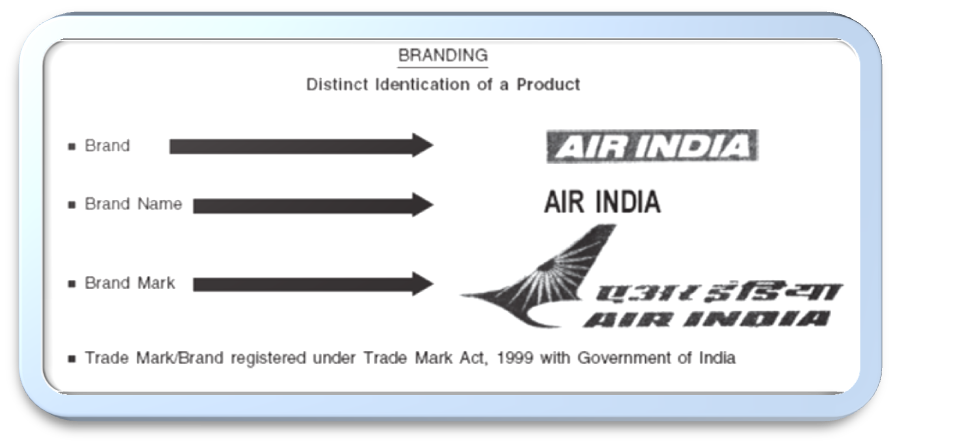- Books Name
- BUSINESS STUDIES-XII
- Publication
- ABCD CLASSES
- Course
- CBSE Class 12
- Subject
- Business Studies
PRODUCT mix:
- Product is a mixture of tangible and intangible attributes, which are capable of being exchanged for a value, with the ability to satisfy customer needs.
Include services, ideas, persons, and places.
Three types of benefits for a customer from the product
- Functional benefits
Car provides the functional utility of transportation
- Psychological benefits
Satisfies the need for prestige and esteem
- Social benefits.
Acceptance from a group
Branding: Branding is a name, term, symbol, or combination of all these which uniquely identify the products and create a corporate brand identity for the consumer. Two components—brand name and brand mark.
-
- Brand Name: Part of a brand, which can be spoken, is called a brand name. For example, Asian Paints, SONY Maggie.
- Brand Mark: Part of a brand that can be recognized but which is not able to express. Appears in the form of a symbol, design, for Example, the tiger on Britannia biscuits
Trade Mark: A brand or part of a brand that is given legal protection is called a trademark.

Advantages to the Marketers
- Product Differentiation: Helps a firm in differentiating its product from that of its competitors. This enables the firm to secure and control the market for its products. Example Sony, Samsung, Nokia.
- Advertising and Display Programmers: Without a brand name, the advertiser can only create awareness for the product and branding increases the sale of the product.
- Introduction of New Product becomes easy: If a new product is introduced under a known brand, it enjoys goodwill and can get a good start.
- Differential Pricing: enables a firm to charge a higher price for its products than its competitors. Nokia, Sony charge higher prices than their competitors
Advantages to Customers
- Status Symbol: Some brands have become status symbols because of their quality. The consumers feel proud and improve their satisfaction level. Like Puma, Nokia
- Ease in shopping: Satisfied customer with a particular brand of a product, customer need not make a close check every time.
- Ensures Quality: Branding means quality. Customer is always confident about the quality McDonald's, Haldiram
Characteristics of Good Brand
- Suggestive it should suggest the product’s benefits and qualities. It should be appropriate to the product’s function. E.g. Boost. Sunsilk, Hajmola.
- Continuing Chosen name should have staying power i.e., it should not get out of date. Lifebuoy( more than 125 years)
- Adaptable should be suitably flexible to hold new products, which are added to the product line e.g., nestle, Samsung.
- Registration should be capable of being registered and protected legally.
- Easy to spell should be short, easy to pronounce, spell, recognize and remember e.g., Ponds, VIP, Rin, Vim, etc
- Disincentive A brand name should be distinctive e.g., GOOGLE, Sprit, MICROSOFT,LG
Packaging: - anything which protects the product from leakages, spoilage, moisture, heat, and mishandling and adds value and life to the product
Levels of Packaging
- Primary Package:
- Refers to the product’s immediate container.
- Ready to use the product (e.g., plastic packet for socks);
- Used throughout the entire life of the product (e.g., toothpaste tube, a matchbox, etc.).
- Secondary Packaging:
- additional layers of protection that are kept till the product are ready for use, e.g., a tube of shaving cream
- Transportation Packaging:
- Further packaging components are necessary for storage, identification, or transportation. For example toothpaste in cardboard boxes containing 10, 20, or 100 units.
Importance of Packaging
- Self-Service Outlets: Self-service retail outlets are becoming very popular, particularly in major cities and towns. Example reliance fresh, easy day, etc.
- Increasing Standards of Health and Sanitation: standards of living in the country are increasing, and more and more people have started purchasing packed goods as the chances of adulteration in such goods are less.
- Innovational Opportunity: packaging has completely changed the marketing scene in the country. milk can now be stored for 4-5 days, traveling pouches of paste, tea, sugar, coffee, canned juices
- Product Differentiation, by looking at the package of a product customers can guess about the quality of the product contained in it.
Functions of Packaging
- Product usage: The size and shape of the package should be such that it should be convenient to open, handle and use for the consumers.
- Identification: Colgate in red color or Ponds cream jar can be easily identified by its package.
- Promotion: color schemes, photographs, or typeface may be used to attract the attention of the people at the point of purchase. In self-service stores, this role of packaging becomes all the more important.
- Enables Protection: protects the contents of a product from spoilage, breakage, leakage, pilferage, damage, climatic effect, etc. This kind of protection is required during storing, distribution, and transportation of the product.
Labeling: - Part of the product that carries information about the product, its contents, method of use, seller, etc.
Functions
- Promotion of Products: Attractive labels can attract customers and can increase sales. For example the label on the soft drink‘20% Extra Free.
- Required Information By Law: For example, the statutory warning on the package of Cigarettes or Pan Masala, ‘Smoking is Injurious to Health’
- Identification of the Product: Labels help to identify the product or brand on its package from many products also including the name and address of the manufacturer.
- Describe the Product and Specify its Contents. Describe the product, its usage, cautions in use, etc. and specify its contents, MRP, expiry date, manufacturing date, batch number, etc.
- Enables grading of products: Grading the products into different categories. Different type of milk is sold by Amul brands under Red( full cream), blue (single tone) yellow(double tone)

 ABCD CLASSES
ABCD CLASSES
